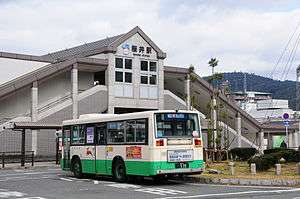Sakurai Station (Nara)
Sakurai Station (桜井駅, Sakurai-eki) is a railway station in Sakurai, Nara Prefecture, Japan. Although the station is on the Sakurai Line as rail infrastructure, it has been served by the Man-yō Mahoroba Line since 2010 in terms of passenger train services. Sakurai Station is also served by the Osaka Line of the Kintetsu Railway.
| commuter rail station | ||||||||||||||||||||||||||||||||||||||||||||||||||||||||||
 The south entrance of Sakurai Station in January 2008 | ||||||||||||||||||||||||||||||||||||||||||||||||||||||||||
| Location | Nara Prefecture Japan | |||||||||||||||||||||||||||||||||||||||||||||||||||||||||
| Coordinates | 34°30′47″N 135°50′48″E | |||||||||||||||||||||||||||||||||||||||||||||||||||||||||
| Owned by |
| |||||||||||||||||||||||||||||||||||||||||||||||||||||||||
| Operated by |
| |||||||||||||||||||||||||||||||||||||||||||||||||||||||||
| Line(s) | ||||||||||||||||||||||||||||||||||||||||||||||||||||||||||
| Distance |
| |||||||||||||||||||||||||||||||||||||||||||||||||||||||||
| Platforms |
| |||||||||||||||||||||||||||||||||||||||||||||||||||||||||
| Tracks |
| |||||||||||||||||||||||||||||||||||||||||||||||||||||||||
| Train operators | ||||||||||||||||||||||||||||||||||||||||||||||||||||||||||
| Bus stands | 4 | |||||||||||||||||||||||||||||||||||||||||||||||||||||||||
| Connections |
| |||||||||||||||||||||||||||||||||||||||||||||||||||||||||
| Construction | ||||||||||||||||||||||||||||||||||||||||||||||||||||||||||
| Structure type |
| |||||||||||||||||||||||||||||||||||||||||||||||||||||||||
| Parking | ||||||||||||||||||||||||||||||||||||||||||||||||||||||||||
| Bicycle facilities | ||||||||||||||||||||||||||||||||||||||||||||||||||||||||||
| Disabled access |
| |||||||||||||||||||||||||||||||||||||||||||||||||||||||||
| Other information | ||||||||||||||||||||||||||||||||||||||||||||||||||||||||||
| Station code | D42 | |||||||||||||||||||||||||||||||||||||||||||||||||||||||||
| Website | JR West website Kintetsu website | |||||||||||||||||||||||||||||||||||||||||||||||||||||||||
| History | ||||||||||||||||||||||||||||||||||||||||||||||||||||||||||
| Opened |
| |||||||||||||||||||||||||||||||||||||||||||||||||||||||||
| Rebuilt | 1995 | |||||||||||||||||||||||||||||||||||||||||||||||||||||||||
| Electrified | JR-West: 1980 | |||||||||||||||||||||||||||||||||||||||||||||||||||||||||
| Traffic | ||||||||||||||||||||||||||||||||||||||||||||||||||||||||||
| Passengers (2016) |
| |||||||||||||||||||||||||||||||||||||||||||||||||||||||||
| ||||||||||||||||||||||||||||||||||||||||||||||||||||||||||
Contactless smart cards including ICOCA (JR-West) and PiTaPa (Surutto KANSAI) are available on both rail systems.
Layout
The elevated Kintetsu Osaka Line and the ground JR-West Sakurai Line are connected by a footbridge.
JR-West platforms
The JR-West station has one side platform and one island platform serving three tracks.
| 1 | ■ Man-yō Mahoroba Line | for Ōji, and Takada |
| 2 | ■ Man-yō Mahoroba Line | for Nara |
| 3 | ■ Man-yō Mahoroba Line | for Nara |
Kintetsu Railway platforms
The Kintetsu station has two side platforms serving one track each.
| 1 | ■ Osaka Line | for Haibara and Nabari |
| 2 | ■ Osaka Line | for Osaka Uehommachi |
 Sakurai Station north entrance in February 2011
Sakurai Station north entrance in February 2011
gollark: It has fairly high conductivity, yes.
gollark: You are now declared a dodecahedron of class 3 (³ (three (drei))).
gollark: WRONG.
gollark: Metalcore, mostly.
gollark: Heavpoot wanted me to make osmarks electromagnetic internet radio™ broadcasting electronic/electromagnetic music, but I don't really have any of that.
See also
External links
| Wikimedia Commons has media related to Sakurai Station (Nara). |
- Official website (JR-West) (in Japanese)
- Official website (Kintetsu)
This article is issued from Wikipedia. The text is licensed under Creative Commons - Attribution - Sharealike. Additional terms may apply for the media files.